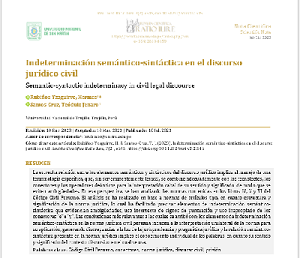Semantic-syntactic indeterminacy in civil legal discourse
DOI:
https://doi.org/10.51252/rcri.v3i2.545Keywords:
Peruvian Civil Code, connectors, legal norm, civil discourseAbstract
The close relationship between the semantic and syntactic elements of legal discourse implies the handling of a specific terminology, which, without being eminently lexical, is adequately combined with technolects, connectors and deontic operators for the full interpretation of its sense and meaning. so that ambiguities are avoided. In this perspective, the norms contained in books IV, V and VI of the Peruvian Civil Code have been analyzed. The analysis has been carried out based on norms of standard articles, in terms of structure and significance of the legal norm, which has made it easier to specify elements of semantic-syntactic indeterminacy that show ambiguities, incorrect use of punctuation marks and inappropriate use of connectors. "e" and "and". The most relevant conclusions reached are: the elements of semantic-syntactic indeterminacy in the Peruvian civil legal norm lead to the unilateral interpretation of the norm for its application, generating discrepancies in the light of jurisprudence and legal pragmatics and the relationship semantic-syntactic present in the legal norm implies the individual knowledge of the words, in terms of their sense and meaning of the discursive context in which it is used.
Downloads
References
Decreto Legislativo N° 295. (23 de marzo de 2022). Artículo 934°. Propiedad. Biblioteca Nacional Del Perú, 24 de marzo de 2022. http://www.bnp.gob.pe/documents/marcolegal/codigo_civil_patrimonio_cultural_nacion.pdf
Fernández González, Á., & Hervás Salvador, B. V. (1977). Intruducción a la semántica (3rd ed.). IberLibro.
Iturralde, V. (1988). Elementos semánticos-sintácticos de determinación de los enunciados normativos en el lenguaje legal. Theoria, 7–8, 157–190. https://addi.ehu.es/bitstream/handle/10810/40018/Theoria7-9157-190.pdf?sequence=1
Martino, A. A. (1987). Sistemas Expertos Legales. Revista de Teoría, Historia y Fundamentos de La Ciencia, 3(1–2), 215–241. https://www.pdcnet.org/theoria/content/theoria_1987_0003_0001_0215_0241
Schmidt, S. (1973). Teoría del texto (15th ed.). Encyclopaedia Universalis

Published
How to Cite
Issue
Section
License
Copyright (c) 2023 Hermes Rubiños-Yzaguirre, Teódulo J. Santos-Cruz

This work is licensed under a Creative Commons Attribution 4.0 International License.
The authors retain their rights:
a. The authors retain their trademark and patent rights, as well as any process or procedure described in the article.
b. The authors retain the right to share, copy, distribute, execute and publicly communicate the article published in the Ratio Iure Scientific Journal (RCRI) (for example, place it in an institutional repository or publish it in a book), with an acknowledgment of its initial publication in the RCRI.
c. Authors retain the right to make a subsequent publication of their work, to use the article or any part of it (for example: a compilation of their works, notes for conferences, thesis, or for a book), provided that they indicate the source of publication (authors of the work, journal, volume, number and date).






